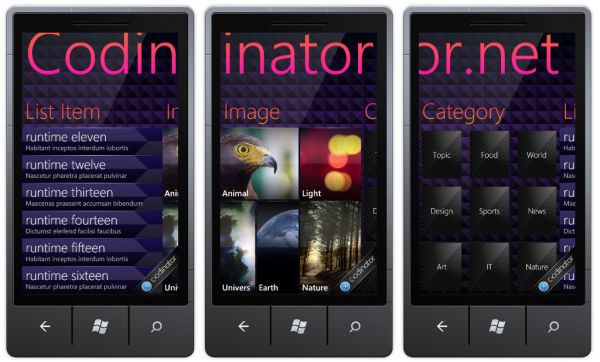Codinator is an efficient GUI (graphical user interface) design program made by South Korean startup Wit Studio. Until now, the software has only supported the very niche and fairly unrecognized Windows Mobile market in South Korea. In fact, the first Windows phone, the Nokia Lumia 710 was just released at the end of last year on December 26. Nevertheless, approximately 24,000 projects have been made with the first version of Codinator and Wit Studio is now ready to release itself from its previous dependence on Microsoft’s Expression Blend with plans to release Codinator 2.0 in March this year. Codinator 2.0 will be an independent and cross-platform version of the software which can be installed on both Windows and Mac computers.
Six months after founding Wit Studio in early 2010, the company received investment from incubator Primer and began developing its flagship product. Around one year later, the first version of Codinator was released in May 2011. As smartphone use continued to increase, the company predicted that GUI design programs would become widely used. However, the main tool for GUI design has always been Adobe Photoshop. Wit Studio’s director Chae Eun-seok explained this factor.
“There are many design programs for other areas of design, but strangely in the field of GUI design, Photoshop has been the only program worth using. As time goes on more people will be doing GUI design and it’s clear that there will be some problems in this area.”
Chae also pointed out the disadvantages of using Photoshop as a GUI design tool.
“Firstly, Photoshop has so many functions that it is difficult for users to know all the different functions. Unless you’re an expert it is hard to get a grasp on every single tool, some that are rarely used. Secondly, because Photoshop is designed for photo editing there are many functions that are not needed for GUI design and actually some functions needed that aren’t on Photoshop.”

One of the tools that Codinator boasts is a color wheel. While this might not sound new, users can pin the colors of various elements of their design on to the wheel and alter colors simultaneously. Another function is “smart lists” which lets users build complex list interfaces with ease. Wit Studio has also catered to those with color blindness or color vision deficiency by providing color vision simulation. This allows developers to test their designs by simulating how they would look to persons with such conditions.
Codinator has essentially been designed for companies who want to adapt to the ever-changing environment of software development. The smartphone market is constantly expanding but trends are changing quickly along with the amount of new devices that constantly come and go. After users have finished their design, because the program is compatible with various devices it is useful when making apps with N-screen features in mind. CEO Kim Dae-wook talked about another stand out feature of the program,
“Another good feature is that Codinator uses less memory compared to other standard UI tools.”
This is because Codinator uses vector images rather than bitmaps which reduces memory usage by 85%. Wit Studio are hoping that its product will appeal to smaller businesses which are trying to reduce costs for projects or UI design.
“At the moment Codinator depends on the Microsoft developers environment but we are creating an independent and cross-platform tool. We intend for designs created with Codinator to be used on all platforms including MFC, HTML5, iOS and Android.”
Wit Studio is also hoping to sell its product overseas by lowering the language barrier and placing emphasis on Codinator’s technology and ease of use.
“Just as Photoshop has become a worldwide tool for designers, we want to make Codinator a competitive product on the market.”
You can view the promotional video for Codinator 2.0 below.
You can view the Codinator website here and follow the Twitter account here.